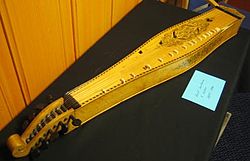Langeleik
 |
|
| String instrument | |
|---|---|
| Hornbostel–Sachs classification | 314.122-6 (chordophone / box zither sounded by a plectrum) |
| Developed | Possibly 16th century |
| Related instruments | |
|
|
| Musicians | |
The langeleik, also called langleik, is a Norwegian stringed folklore musical instrument, a droned zither.
The langeleik has only one melody string and up to 8 drone strings. Under the melody string there are seven frets per octave, forming a diatonic major scale. The drone strings are tuned to a triad. The langeleik is tuned to about an A, though on score the C major key is used, as if the instrument were tuned in C. This is for simplification of both writing and reading, by circumventing the use of accidentals.
Since the instrument cannot play a chromatic scale nor be easily tuned to other pitches, it is very limited in its ability to play along with other instruments and/or more harmonically complex music.
The combination of the lone melody string and the multiple drone strings gives the langeleik a distinctively rich sound.
There exists a variety of box zithers in Europe. The German scheitholt and the Swedish Hummel have been suggested as the predecessor of the langeleik. However, in 1980 a langeleik dated as early as 1524 was uncovered on a farm in Vibergsroa, Gjøvik, Norway. This instrument predates any documented occurrences of the scheitholt, the hummel or any other similar instrument.
The older Langeleik types were tuned after Pythagorean fashion, based on pure fifths and octaves, with variable smaller intervals. Thus, the pitches could easily be moved between more sombre "low" intervals and the more bright major ones. The fixed Langeleik with a recognizable major scale is dated to after 1850. After this change in tonation, many players had to change their melodies, or find new ones, as the older repertoire no longer fitted into the new system.
Early langeleiks are basically rectangular in shape, and often have an open bottom. They usually have five or six strings. They often had unique traditional scales other than the modern major scale (using 3/4 tones, etc.). Especially the third and seventh tend to be different; the third is often neutral (between a major and minor third) and the seventh tends to be lower than the modern leading tone.
...
Wikipedia
